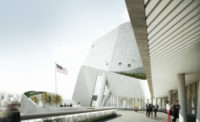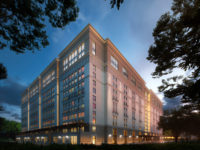With a little more than a month before the opening of the 13th Venice Architecture Biennale, firms around the world are finalizing contributions to the massive show, a grab bag of architecture and architecture-related exhibitions that will run from August 27 though November 25. As usual, there will be an “official” exhibition, this time curated by the British starchitect David Chipperfield, with the title Common Ground, and 55 separate national displays (with Angola, Kosovo, Kuwait, and Peru joining 51 returning countries).
Many of those national displays are government-supported, but in the U.S., the majority of funding must be raised privately. Cathy Lang Ho, the freelance writer and editor who is serving as U.S. commissioner, said it’s both a disadvantage that the government isn’t more forthcoming (the State Department puts up a bare $100,000), but also an advantage, since she had free rein to create an exhibition without Washington’s imprimatur.
What she has chosen to do with that freedom is display 124 architect-initiated projects that in most cases lack clients or budgets of more than a few hundred dollars. Grouped under the headline Spontaneous Interventions, they include guerrilla bike lanes, spray-painted at night; a pavilion in San Francisco where visitors eat soup while waiting for soil samples from their yards to be tested; and a mobile produce market meant to serve urban “food deserts.” While all the projects had to have been previously realized, few of them are buildings, and some are apps and websites.
Given economic conditions in the United States, “a show about high-end architecture for a very small group of people would not be the right thing right now,” says Ho. “the projects are about asserting democracy—which is what’s happening in architecture and design right now.”
To choose the projects, from among 450 entries, Ho worked with the Institute for Urban Design and a group of advisors led by the Institute’s board chair (and longtime Record contributor) Michael Sorkin. The projects will be shown on banners, which visitors will be asked to unfurl. With everyone at the Biennale “on information overload, it was important for the exhibition to be strong experientially,” Ho says. Freecell, a Brooklyn studio, designed the installation of the banners, and Interboro, a Brooklyn firm known for its P.S.1/MoMA Young Architect’s Program installation last year, designed a lounge outside the neoclassical U.S. pavilion. Is this the Grand Canal or Grand Army Plaza?
Many American architects will also be represented under the Common Ground umbrella. Chipperfield, who was appointed only last December 27, announced a theme that, like all good Biennale themes, can mean almost anything participants want it to mean. Common Ground, he has said, reference both new models for shared space, and “the ideas we all share about architecture.” Chipperfield tapped 63 people (including architects as well as horticulturalist Piet Oudoulf and photographer Thomas Struth) to help curate the show. Kenneth Frampton, the Columbia University architectural theorist, will present work by Steven Holl, Patkau Architects, Rick Joy, Shim/Sutcliffe, and Stanley Saitowitz. Peter Eisenman, also tapped by Chipperfield, is working with students at Yale to adapt Piranesi’s Campo Marzio drawing into a digital 3-D model. And Tod Williams and Billie Tsien sent empty wooden boxes to 35 people, asking them to fill the containers with “things that inspired them,” Tsien says. (Eisenman received one of the boxes and is filling it with a grid.)
Among the national pavilions, standouts are likely to include Portugal’s display, with works by its two Pritzker Prize winners, Alvaro Siza and Eduardo Soto de Moura, and Japan’s, where commissioner Toyo Ito will present works by up-and-comers, such as Sou Fujimoto and Kimiko Inui.








